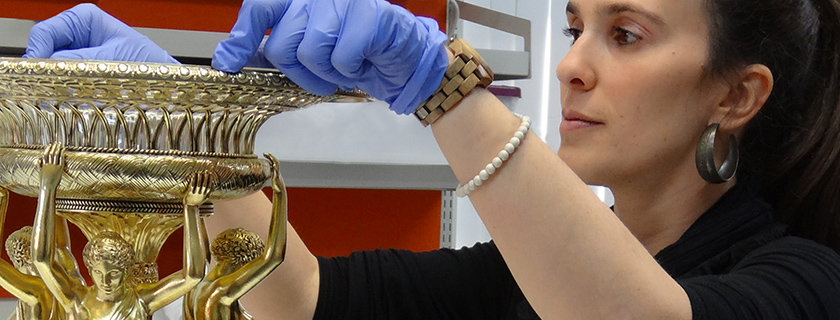 Paul Storr, silversmith, Britain, 1771 – 1844. Attributed to John Flaxman, designer, Britain, 1755 – 1826, Rundell, Bridge & Rundell, retailer, Dessert stand, 1812‑13, London, silver gilt, glass, 62.0 x 38.0 x 38.0 cm; Gift of Mr & Mrs J.H. Borthwick and family fund assisted by the Art Gallery of South Australia Foundation 1993, Art Gallery of South Australia, Adelaide
Paul Storr, silversmith, Britain, 1771 – 1844. Attributed to John Flaxman, designer, Britain, 1755 – 1826, Rundell, Bridge & Rundell, retailer, Dessert stand, 1812‑13, London, silver gilt, glass, 62.0 x 38.0 x 38.0 cm; Gift of Mr & Mrs J.H. Borthwick and family fund assisted by the Art Gallery of South Australia Foundation 1993, Art Gallery of South Australia, Adelaide
The state’s decorative arts collections are cared for by Artlab’s objects conservators who consistently ensure they are well maintained by checking their condition, cleaning and undertaking conservation treatment when required. Generally, conservation treatment involves assessment, documentation, cleaning and/or stabilisation of breaks and losses.
We regularly prepare objects for storage, display and transport and provide information for the ongoing care of the object. We offer advice or assistance regarding the construction of display supports and storage containers.
Our private clients bring in an extensive range of decorative arts, challenging us to provide conservation treatments that are sensitive to their needs as they cherish their objects for their collectability, aesthetic pleasure and particularly for their sentimental value.
Decorative arts encompasses the widest variety of object and material combinations over a broad timeline of styles and origins. Ceramics, pottery, glass, metals, wood, ivory, bone, stone, wax, plastics, resins, rubber, leather, fur, feather and textiles, with varieties of embellishment and surface decorations, singularly or in various combinations, are some examples.
Due to the broad range of materials decorative arts are made from, our techniques must draw from an extensive variety of solvents, adhesives, fillers, pigments and dyes to stabilise or replicate the object’s parts. Our sophisticated equipment such as laser cleaning, microscopes and analytical tools, including Fourier-transform infrared spectroscopy (FTIR) and ultraviolet light examination (UV), is used to examine particular materials or an earlier restoration.
A conservation treatment can be highly transformative after a comprehensive period of work and the enthusiastic response from the client when they see their conserved decorative art piece is a truly rewarding experience for our conservators.


